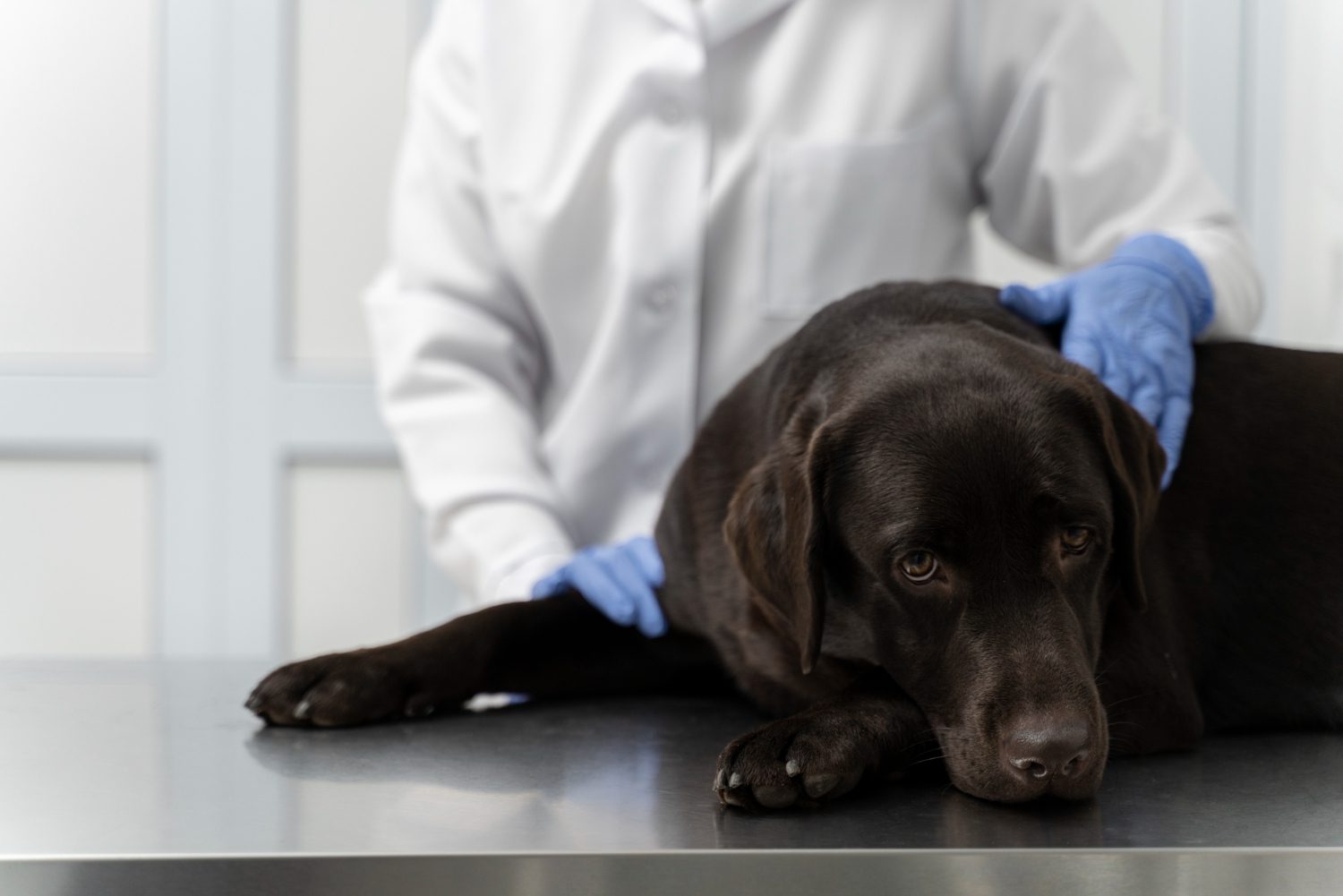Tetanus in Dogs: Signs and Management

By Evelyn Harcourt
September 02, 2025 - 1 min read
Although tetanus is a very rare condition, it has the potential to be quickly fatal, making it an important neurological disease for dog owners to be aware of.
Many people call tetanus ‘lockjaw’ as it can make the muscles rigid and give those affected a rigid-looking face and mouth.
In this article, we examine the classic symptoms of tetanus, how a vet diagnoses it, and how it can be managed. We also explore the prognosis and potential complications. Importantly, we discuss techniques to avoid contracting this potentially deadly infection in the first place.
What is Tetanus in Dogs?
Tetanus in dogs is caused by the bacterium Clostridium tetani, which can also infect other mammals such as horses, sheep, and humans. Dogs are generally more resistant to tetanus than humans, with only a handful of cases reported each year.
Cats are even more resistant, and natural infections in them are extremely rare, to the point of being considered almost negligible.
How Dogs Get Tetanus
Clostridium tetani's hardy spores live in the ground and can survive for up to 40 years. If they manage to enter a deep wound, they have the potential to proliferate and release a neurotoxin.
Most cases occur when a dog develops a puncture wound from a bite or laceration, which is then contaminated by soil or dirt. Surgical wounds can also become infected.
Why Tetanus Is Dangerous
The neurotoxin is released when the bacteria grow, thriving in the low-oxygen environment of the dog’s wound. The chemical affects muscle movement, blocking inhibitory signals and causing hyperactivity in neurons.
The effect on neurons leads to spasms and rigid movement as the muscles are unable to relax.
As well as muscle damage and pain, this bacterial infection has the potential to make a dog stop breathing and to cause heart failure. Sadly, it can be fatal.
Causes of Tetanus in Dogs
Although exceedingly rare, there are several cases of tetanus in UK dogs yearly.
Common Sources of Infection
Tetanus in humans is often associated with rusty nails being stood on, and the bacteria do tend to live on rusty things. However, there are lots of other potential infection sources, such as sticks or thorns- particularly if they are contaminated with soil or manure.
Risk Factors for Dogs
The main risk factor would be obtaining a puncture wound and it getting dirty or contaminated.
This can mean a bite from another animal or a piercing wound if something is trodden on. Dogs can also develop deep wounds if they run into a sharp branch or fence.
There is a potential risk from surgical wounds and dental disease, too. Historically, puppies would sometimes develop tetanus if they were kept in very unhygienic conditions and their umbilical stump became infected.

Signs and Symptoms of Tetanus
This condition has a dramatic presentation, so let’s take a look at what can be expected.
Early Symptoms
Initial symptoms usually consist of localised muscle spasms and stiffness. The muscles affected are generally those that are closest to the lesion. Clinical signs present about a week after the wound occurs, but can take almost three weeks to develop in some more resistant dogs.
Advanced or Severe Symptoms
If the condition progresses, symptoms can become much more worrying. Muscles all over the body are affected, and the dog limps or stands and walks like a ‘sawhorse’.
The facial muscles can grimace into a permanent smile, with a wrinkled forehead and eyebrows that are drawn close together.
The dog is sensitive to light and sounds, and they may experience laryngeal spasm (which can sound like a cough), struggle to swallow and have trouble breathing.
How Tetanus Differs from Other Conditions
Many people associate tetanus with rabies, and both are neurological infections which humans and dogs can develop via wounds or bites.
However, they are quite different medical conditions. Rabies is a virus transmitted through saliva with a much higher fatality rate.
How Tetanus is Diagnosed in Dogs
Prompt diagnosis is essential for improving survival rates, so seek emergency veterinary care if you have any suspicion your dog could be infected.
Veterinary Examination
Your vet will examine your dog and feel its muscle tone, checking for tell-tale signs such as localised stiffness or rigidity. They’ll also look for evidence of an infected puncture wound.
Laboratory Testing
Vets usually base their diagnosis on the dog’s history and physical exam. While an antibody blood test is available, the results take time to come back and are not always reliable.
Ruling Out Other Diseases
Lab tests may be run in cases where tetanus is suspected but there is uncertainty. Blood tests, X-rays, abdominal scans and CSF taps can all play a role in ruling out other conditions such as rabies, leptospirosis, meningitis, lyme disease, or a toxin ingestion.

Management and Treatment of Tetanus
It is well known that the more promptly treatment is delivered, the better the outlook.
Wound Cleaning and Care
Thorough wound disinfection can help remove the bacterial spores. The wound should be flushed with hydrogen peroxide, and any dead tissue should be surgically debrided.
Importantly, vets must give a tetanus antitoxin before debriding the wound, as the debridement procedure releases more toxins.
Antibiotic Treatment
Intravenous metronidazole is given every 8 hours for a minimum of 10 days, and the duration may be longer for some.
Muscle Relaxants and Pain Relief
These dogs are in a lot of pain and physically unable to stop their muscles contracting. Both muscle relaxants (such as diazepam) and pain relief are essential for keeping them comfortable and allowing them to rest and sleep as they recover.
Supportive Care and Hospitalisation
If severely affected, dogs should be kept in the clinic. They need monitoring to ensure they do not choke or develop hypoxia (low blood oxygen). These patients need a calm, quiet, and dimly lit room.
Those who are not walking will need help preventing pressure sores. Some will need tube feeding, as well as bladder expression, if they are not physically able to release urine.

Recovery and Prognosis for Tetanus in Dogs
The prognosis is variable and depends on how severely the dog is affected, as well as on how quickly their therapy begins.
Duration of Recovery
During the recovery process, dogs have to form new nerve terminals. This is not a quick process and takes a minimum of 1-2 weeks. However, after 3-4 weeks, most dogs are fully recovered.
Possible Complications
The literature reports REM disorders that occur after tetanus, once the dog has recovered. These mimic seizures, so vets should warn owners about them. Almost half of surviving dogs can experience twitching and other movements as they dream. This usually improves over time.
Sadly, death is a possible outcome once tetanus has been contracted. However, the canine survival rate is quoted as between 50 to 92%.
Preventing Tetanus in Dogs
A wound is not identified on every dog that has tetanus, but it is known that penetrating wounds massively increase the risk of infection.
Safe Wound Management
When your dog develops a wound, disinfect it immediately. You also want to keep it clean and away from mud, soil, or manure. Dogs should not be allowed to lick at their wounds, which can mean the use of dressings and buster collars.
Avoiding High-Risk Areas
Farms and areas with lots of mud and soil are high-risk areas, as the spores can live on these for years. When your dog has a deep wound, keep it away from dusty or muddy areas until it is healed.
Routine Health Checks
Tetanus is not something we vaccinate dogs against in the UK. As they are quite resistant to tetanus, there is no call for it.

Learn More About Tetanus in Dogs
If you have any remaining questions about tetanus, contact us to learn more. Our friendly team is always happy to advise and guide you.
Tetanus in Dogs FAQs
Can Dogs Be Vaccinated Against Tetanus?
Theoretically, dogs can be vaccinated against tetanus. However, as it is so rare in the UK, this is not done in practice.
Is Tetanus in Dogs Contagious to Humans?
Thankfully, infected dogs cannot pass the condition on to humans or to other pets. The disease is contracted from bacterial spores living in the environment and must penetrate the skin.
How Soon Should I See a Vet for a Wound?
Most small wounds can be treated at home with first aid. Owners should do what they can to keep wounds clean. Deeper wounds or those requiring sutures require more urgent care.
Continue reading

Sepsis in Cats: Causes, Diagnosis and Treatment
Sepsis in cats is a critical infection. Discover causes, warning signs, diagnosis, and lifesaving treatment.
Read article
Cat Bleeding When Urinating: Causes and Treatment
Is your cat bleeding when urinating? Learn causes, symptoms, and urgent treatment options.
Read article
Poisonous Food for Dogs: What You Shouldn’t Feed
Learn which common foods are poisonous to dogs and how to keep your pup safe from harm.
Read article